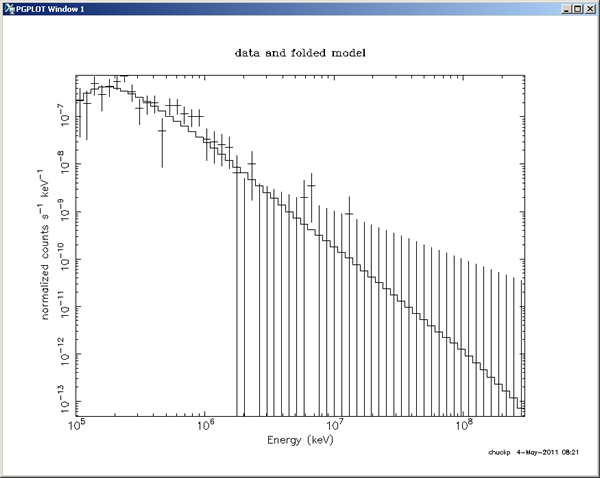2. XSPEC: Part 1
|
2. XSPEC: Part 1 Also see: |
Note: No background file is necessary to perform a spectrum analysis of a Gamma-ray burst; only a PHA file with the spectrum and an RSP file with the DRM are required. It is expected that all non-burst sources will produce less than 1 photon in the extraction region during the burst. The following details only the simplest example of fitting a spectrum with XSPEC; for further details, consult the XSPEC manual.
Prerequisites
You must have the two files necessary to analyze the burst spectrum with XSPEC:
- A PHA file with the spectrum (e.g., GRB080916C.pha)
- An RSP file with the DRM (e.g., GRB080916C.rsp)
Procedure
- To start XSPEC, enter:
xspec
Note: If you are running on a Windows machine, use
X-Win32 as your X server.Tip: To see a summary of xspec commands at any time,
enter:
- Load in the data:
help
?
- Load in the DRM:
- Load in a power law model
- Choose the parameters' initial values.
Note: Power law indices tend to be near 2 for gamma-ray sources; in this tutorial, the default values were used.
- Fit the data:
- Change plotting device (e.g., pgplot X-Window server /xw):
Tip: When queried "Number of trials exceeded: continue fitting?", hit the enter key until the fit has completed. (See Example: XSPEC Fit.)
- To look at the fit using energy as the x-axis, enter:
The following plot will be displayed. (Note: If you're running on a Windows machine, be sure you're using an X-Win32 terminal window.)
Note: You may be prompted for the lower and upper energy boundaries; these are provided in units of kev. Issues to consider are:
- The number of photons in the spectrum.
- The number of counts per bin (and therefore the number of bins).
- The energy range that should be fit.
- The fitting statistic
- To perform rebinning, additional fits, and view additional plots, etc.; continue this session and refer to Run XSPEC: Part 2.
| Last updated by: Chuck Patterson 05/04/2011 |
